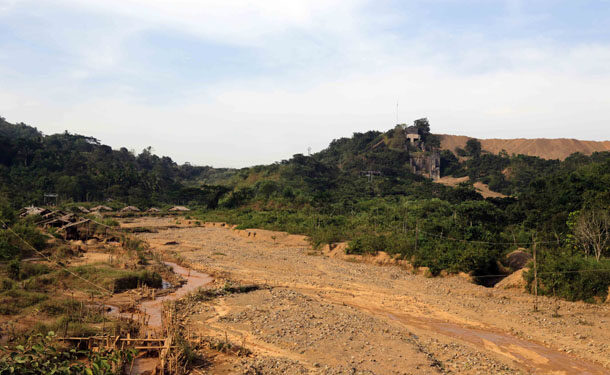TENASSERIM HILLS, Dawei District — Soe Aung used to be a farmer, growing rice, betel nut and coconut on a 5-acre plot of fertile land located along a stream flowing from the lush mountains around Myaung Pyo village.
These days he is a day laborer, and his land, along with the stream that ran past it, has disappeared, covered under a layer of reddish-yellow mud.
“Before I had land, but it’s been ruined by flooding from the mine,” said Soe Aung, 49, looking haggard. “Now I’ve become poor, my family is so troubled by this situation. I can only try to work as a laborer in the area to get some money.”
He recalled how wastewater from the Heinda tin mine, located on a mountaintop about 2 kilometers away, was released from a reservoir during the past few rainy seasons, flooding Myaung Pyo village without warning, contaminating local wells and gradually covering all farmland to the east of the village with mud.
“Many farmers here lost their land, about 30 farmers in total,” adds his brother, Soe Naing, 48, whose farmland was also destroyed. “I cannot afford to send my children to school anymore.”
Now, the expanding mud plain, about a kilometer wide, has reached the edge of this village, located in Dawei District in a valley in the Tenasserim Hills in the eponymous division in southern Burma. The Thai company that owns the mine, Myanmar Pongpipat Company Ltd, has erected a small earthen wall to protect local homes.
The continuous runoff from the mine, however, seeps through the wall, and the ethnic Dawei villagers have dug a network of small trenches to channel putrid, black waste water around their bamboo and thatched-roof homes.
The roughly 150 impoverished families have received some support from the Dawei Development Association (DDA), a local community rights NGO that has dug several wells in the village, but they are despondent about the future. “Before this village was prosperous, but now most youths have gone to Thailand to work,” said Soe Aung.
Myaung Pyo is the worst affected of about 10 villages that suffer from the environmental impacts of the tin-ore mining operations, located about 25 km east of Dawei town.
The Tenasserim range, running north-south along the Burma-Thai border, is rich in mineral wealth, and tin and tungsten deposits have been mined at Heinda and other sites from British colonial times. Since Burma began opening up under a reformist government in 2011, dozens of mining firms have shown an interest in exploring the region and mining activities have increased, as have local fears over the projects’ environmental impacts.
Thailand’s Myanmar Pongpipat Company took over the Heinda mine after signing a production-sharing contract with the state-owned Mining Enterprise 2 in 1999, when Burma was under military rule. The Thai firm reportedly holds rights to 65 percent of produced tin and tungsten, which is transported to nearby Thailand for processing.
From Myaung Pyo village, a 30-minute drive across jungle-covered slopes leads to the Heinda mine, a vast wasteland that runs about a kilometer across, cut out of the side of a mountaintop. At the site, which offers sweeping views of the verdant Tenasserim Hills, excavators scoop up gravel and load it into a dozen trucks that drive up and down the red moonscape.
The vehicles dump the alluvium down mountainsides, where workers operate high-pressure jets of water that turn it into slurry, which then passes through plants that separate the heavy tin and tungsten from lighter minerals and sand.
Massive volumes of muddy wastewater are continuously pumped out of the plants and down mountain slopes into streams. These tributaries of the Tenasserim River are swollen with yellow wastewater and frequently flood villages below the mine, dumping a layer of mud on the farmland. The streams have become lifeless due to a lack of oxygen, and their waters are now unfit for human consumption or irrigation.
A Thai manager of Myanmar Pongpipat Company at the mine’s office refused to talk to Irrawaddy reporters and waved away questions about the mine’s environmental and social impacts.
About 500 laborers are said to be employed at the mine, and some reportedly suffer from respiratory and skin disease as a result of poor working conditions, but reporters were barred from talking to workers.
On the other side of mountain, at the ethnic Karen village of Lower Heinda, residents also suffer from the mine’s environmental impacts. Large tracts of farmland have been flooded by the mine’s continuous runoff and a huge waste water reservoir that the company built next to the village.
“We are worried the dam is not high enough and that in the rainy season it could flood, as our village lies much lower” than the reservoir, said Ngwe Soe, 39, adding that the runoff has also contaminated local water sources.
“The water quality is very poor here,” he said, adding that several villagers had developed illnesses due to water pollution. “I became sick. I went to Yangon to get medical treatment for kidney problems. The treatment and travel expense cost me 300,000 kyats [US$300].”
The environmental impact has worsened in recent years after Myanmar Pongpipat Company drastically increased production, according to Ngwe Soe. “This mine has been here a long time, but since four years the Thai company has created a lot of problems,” he said.
The firm, local authorities and the Karen National Union (KNU)—an ethnic rebel group that controls the mountain territory around the mine—have ignored the villagers’ demands to end the pollution and offer compensation for loss of land, he said. “The company has power, they know the government, so we cannot complain,” Ngwe Soe added.
Zaw Thura, a local activist with DDA and a Dawei University scholar, said the communities repeatedly protested to local authorities and the KNU, but to no avail. Myanmar Pongpipat, he alleged, “pay off both sides; they are businessmen they know what to do.”
Some villagers, however, have managed to eke a living out of the waste water dumped in their backyard. About 20 people living directly below the mine have set up sluice boxes through which they channel waste water. From it they collect several kilograms of fine black sand containing tin ore.
In a scene reminiscent of the famous 19th and 20th century US gold rushes, they stir the collected material in water in a funnel-shaped pan and wash sand and mud over the side, leaving the heavier tin particles behind.
The repetitive, painstaking work has proven to be a boon for a few enterprising villagers. “Before I used to grow betel nut, but now I do this work for my daily income,” said Myo Ko, 25, adding that he can earn up to $200 per month from collecting tin and tungsten. “We sell it to the Thai mining company.”
Mining Firms Eager to Explore Uncharted Hills
Khin Maung Aye, president of the Tenasserim Division Chamber of Commerce and Industry, said Burmese, Thai, Chinese and other foreign mining firms are keen to explore the largely uncharted Tenasserim Hills for mineral wealth, adding that “many companies” have applied for government licenses in the past few years.
“At least 55 companies are trying to get a permit… Mostly in Dawei District and mostly for tin production,” he said. “They are waiting for a decision from [the government in] Naypyidaw.” He added that 10 firms are currently licensed to mine or explore for ores in the region, up from six companies a few years ago.
Indonesian state-owned mining giant PT Timah told media Wednesday that it expected to begin exploration of a 10,000-hectare mining concession in Tenasserim Division in June and mining operations in early 2015. The firm, which did not specify the location, said it expected to unearth 10,000 tons of tin and would build a $12 million smelter to process ores in Burma.
President Thein Sein’s government has said it is eager to attract foreign direct investment to Burma’s mining industry, but a lack of progress on reforming the 1994 Mining Law and long processing times for mining license applications have reportedly dimmed investors’ enthusiasm. An overhaul of the legislation is expected this year and is likely to bring many more mining firms to Burma, including to the Tenasserim Hills in Dawei and Mergui districts.
Burma’s southernmost region was long an isolated backwater, located far from Rangoon and cut off from nearby Thailand because of a KNU-insurgency in the densely forested hills. But a 2012 KNU-government ceasefire, planned construction of the Dawei Special Economic Zone and new transport links to the Thai border, located about 130 km east of Dawei town, are quickly improving access to the area.
“Now, many many mining companies are trying to get permission to search for tin, tungsten, lead, coal and gold—especially for gold along the Tenasserim River,” said Zaw Thura, the activist. “Nobody knows how much [mineral wealth] there is because the last 50 years this was an insurgency area.”
He warns that due to poor implementation of Burma’s mining and environmental laws, local communities stand to lose rather than gain from these developments, as they are likely to experience only the negative social and environmental impacts. “We are really worried about the impacts, but we can’t stop them because we have no money and power. We have only people,” he said.
Khin Maung Aye, of the Tenasserim Division Chamber of Commerce and Industry, shared these concerns, saying, “Most [mining] companies working in our region don’t care about social responsibility, they only care about production. That’s why there are many problems.”
Zaw Thura said KNU insurgents also welcomed mining projects into their areas of control, despite the impacts on the impoverished Karen communities who live in the Tenasserim Hills.
In a remote, forested area in southern Dawei District, controlled by the KNU’s Karen National Liberation Army Brigade 4, Thailand’s East Star Company and local firm Mayflower have been allowed since 2011 to operate a coal mining concession. The operations have reportedly angered local Karen communities, who complain the firms are polluting their water sources and damaging farmland.
“It’s just the exploration phase, but they are already digging everywhere,” said Zaw Thura, adding that a road was cut through the dense forest so that East Star could transport coal deposits to Thailand. “East Star Mining, they neglect everything. We [DDA] complained to the company and the KNU many times, but still they don’t want to talk,” he said.
Officials from the Tenasserim Division government and the Ministry of Mines could not be reached for comment.

















